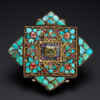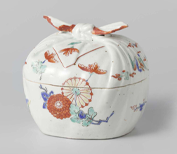PENGLIANG LU
Associate Curator, Department of Asian Art, The Metropolitan Museum of Art

CLOISONNÉ ENAMEL suddenly appeared in China around 1400 and thereafter became a main category of Chinese decorative arts. Known better in China as “Jingtai Blue”, this type of enamel ware with various blue colours is dominant, and is thought to have achieved its production summit during the era of the Ming (1368–1644) Jingtai emperor (reigned 1450–1457). Some fundamental questions about early Chinese cloisonné, however, are still under discussion among scholars and collectors in China and the West. When did Chinese artisans start to make cloisonné enamel? Why is Jingtai era cloisonné so famous? How to date early Chinese cloisonné from the 14th to the 15th century accurately? Instead of answering all these questions categorically, this article aims to provide some clues for future study based on several artworks now on display in an exhibition that the author curated at The Metropolitan Museum of Art (The Met), New York.
The exhibition, “Embracing Color: Enamel in Chinese Decorative Arts, 1300–1900”, explores the transformative, but often overlooked, role enamel played in Chinese decorative arts throughout the Ming and Qing (1644–1911) dynasties. Drawn mainly from The Met collection, the more than 100 objects on view, including works in other media such as ceramics, bronzes, lacquerware and textiles, are arranged in two sections by period to illustrate two pivotal moments in which enamel radically transformed the colour palette and aesthetic preference in China. The first transformative moment occurred in the late 14th to 15th century, when the introduction of cloisonné enamel from the West, along with the development of porcelain with overglaze enamels in China, led to a shift away from a monochromatic palette to colourful works. The second transformation occurred in the late 17th to 18th century, when European enamelling materials and techniques were brought to the Qing court, leading to the local development of more subtle and varied colour tones applied over metal, porcelain, glass and other media. In both moments, Chinese artists did not simply adopt or copy foreign techniques: they actively created new colours and styles that reflected their own taste. Some highlights in the first section, including a few recent acquisitions of the museum, would be helpful for us to understand the aforementioned questions about early Chinese cloisonné enamel.

Beginning of Cloisonné Enamel in China
The origin and early development of cloisonné in China is still contested among scholars. Following Sir Harry Garner’s pioneering study in the 1960s, Western scholars mostly agreed that there were no known examples dating earlier than the 15th century.1 Since the 1980s, however, some Chinese scholars have claimed some examples— mainly in the collection of the Palace Museum, Beijing—to be dated as early as the Yuan dynasty (1271–1368).2 Recently, this early attribution was accepted in a major exhibition of Chinese cloisonné enamel held at the Bard Graduate Center (BGC), New York. In that exhibition, “Cloisonné: Chinese Enamels from the Yuan, Ming, and Qing Dynasties”, a few pieces loaned from the Musée des Arts Décoratifs, Paris, and one from The Met were attributed to the Yuan or early Ming dynasty.3 Such an early date is not unquestionable either from stylistic analysis or reliable historical documents.

Attributed as one of the early examples, The Met vase would be a good starting place for some stylistic analysis (1). In the BGC exhibition catalogue, the lower body of the vase was dated to the Yuan or early Ming dynasty, while its neck, base, animal-formed handles and feet were added later during the Kangxi reign (1662–1722).4 The lower body, once a jar, features brighter enamel colours than the other later parts. The floral scrolls were thought to be characteristic features of early designs, including large flowers with curving petals and tulip-shaped buds at the intersection of scrolls connecting flowers. Such a design, however, appears to be hard to date conclusively to the Yuan dynasty when compared to artworks in other media, especially blue and white porcelain. The flowers on Yuan porcelain are often painted in a more naturalistic way (2). More characteristically, those small tulip-shaped buds between large flowers are very rarely seen on Yuan blue and white porcelain. Such “tulips” only started to appear on early Ming imperial wares from the very end of the 14th century and became a common design from the 15th century onwards (3). It is also not uncommon on works in other media from the 15th century imperial workshops, such as ones in lacquer (4) and textile (5). The “stylistic” rendering of floral scrolls would be more safely dated to the 15th century based on the standardised pattern of the imperial Ming workshops, rather than the earlier Yuan period.

Historical documents concerning Chinese cloisonné can also only be traced back to the early Ming period. The earliest surviving, unambiguous mention of cloisonné enamels in China is an entry in the influential collector’s manual, Gegu yaolun (The Essential Criteria of Antiquities), first published in 1388. Cao Zhao (active late 14th century), the author, listed Dashi yao (Tabriz or Muslim ware) under the category of ceramics, noting:
The base of this ware is of copper, and designs on it are in five colours, made with chemicals and fired. It is similar to the inlay of Folang. I have seen pieces such as incense burners, flower vases, boxes, and cups, which are appropriate for use only in a woman’s apartment, and would be quite out of place in a scholar’s studio. It is also known as wares from the Devil’s country.5 (Gegu yaolun, volume III, folio 3)
This well-cited document has often been used as evidence of the appearance of cloisonné in China. As this book was first published in 1388, twenty years after the collapse of the Yuan dynasty, it was thought that production of cloisonné should have already started in the late Yuan period. Cao’s way of writing, observed in notes in the book, reveals, however, that cloisonné might not be traceable back to the Yuan dynasty. When Cao discussed other ceramic wares, he clearly noted their periods, especially those pieces from the Yuan dynasty. He noted that Ge ware, made at the end of the Yuan era, was coarse and not a very good colour; Raozhou (Jingdezhen) ware, made in the Yuan dynasty with a Shufu mark, was superb; and Huo ware was invented in the Yuan dynasty by the ceramic master, Peng Junbao. If cloisonné production began in the Yuan period, Cao would have noted it. Furthermore, Cao didn’t add the prefix gu, or antique, to Dashi ware as he usually did with other historical ceramic wares. A possible explanation is that cloisonné enamel was contemporary with Cao, beginning from the late 14th century.


Another important clue lies in Cao’s note regarding Dashi ware’s similarity to “the inlay of Folang”. In Chinese historical documents, Folang is the name for Rome. Here, such inlay works undoubtedly come from Byzantium, the centre of cloisonné enamel production during the mediaeval period. Although most Byzantine cloisonné works feature Christian icons, some ornamental panels with floral scrolls do display certain similarity to Chinese examples. Once part of a cover for an icon of the Virgin Hagiosoritissa, some fragments now in The Met collection illustrate such meandering flowers in a bright and colourful tone (6). If we compare them to early Ming examples, their pattern and colour palette are pretty close (7). It is very likely that Cao did see Byzantine cloisonné enamel with his own eyes. Such similarities may also explain why falang, a deviation from “Folang”, gradually became the general term for enamel in China. As no Byzantine enamel works have been found in China to date, it is still too early to establish a direct connection between Byzantium and China and we must wait for archaeological discoveries to provide evidence.
The above stylistic and textual analyses indicate that Chinese cloisonné enamel more likely began in the early Ming, instead of the Yuan period. The first stage of Chinese cloisonné development should fall into a period from the late 14th to the early 15th century, before the Xuande period (1426–1435), when works with reliable reign marks appeared. Examples from this period show certain similarity to Byzantine cloisonné and match the ornamental style observed in contemporary works in various other media.


The Legend of Jingtai
Another major question about Chinese cloisonné enamel is how to identify pieces from the Jingtai reign (1450–1457), reputedly the golden age of Chinese cloisonné production. The Jingtai mark is much more common than any other reign mark on Chinese cloisonné, but most of these marks were added later (8). Sir Harry Garner even stated that the Jingtai mark was used no earlier than the mid-17th century and he treated Jingtai cloisonné as “a complete myth”.6 Instead of trying to chase works from this legendary period, it might be more realistic to look into the development of cloisonné in a slightly wider time period, say the mid-15th century.

Historical texts reveal that there was a possibility of sophisticated cloisonné production during the Jingtai era. The aforementioned Gegu yaolun was revised and expanded by Wang Zuo in 1456 and republished in 1459. The entry for Dashi ware was expanded and it was noted: “… nowadays people from Yunnan work in the capital and mainly make wine cups, often known as inlays from Devil’s Country (Guiguo qian); the pieces produced in the imperial court are delicate, lustrous and lovely”.7 As 1456 was the seventh year of the Jingtai reign, this note reflects the imperial production of the time and the contemporary connoisseur’s attention on cloisonné. Such an attitude shift towards the use of enamel reveals the changing tastes of artists and those who commissioned their work from sixty-eight years before when the original book was published. The imperial Ming workshops experienced successful developments from the late 14th to the 15th century in almost every type of craft, ranging from porcelain, lacquer, metal to textile. Splendid, exquisite and colourful designs became the representative visual language of the period. It is no surprise then that cloisonné with vivid colours was appreciated in the court. Actually, polychromatic enamels provided the technical ground and aesthetic appeal for the change of the colour palette in Chinese decorative arts. Slightly later than cloisonné enamel, imperial potters also invented new ways to use polychromatic enamels on porcelain, such as famous doucai ware featuring both underglaze cobalt blue and overglaze colour enamels (9). Polychromatic objects became an aesthetic mainstream in the following centuries.

The fame of Jingtai cloisonné was also noted in late Ming literature. By the 17th century, it had become an iconic type of Ming artwork. In his memoir of Beijing, titled Chunming mengyulu, Sun Chengze (1592–1676), a famous statesman and art collector, recorded that “works from the Inner Court, such as bronzes of the Xuande period, ceramics of the Chenghua period (1465–1487), lacquers from the Guoyuanchang of the Yongle period (1403–1424), and cloisonné from the imperial workshop of the Jingtai period, are all much more delicate than older works. Collectors and dealers from all over come to the inner market to purchase these works at high prices.”8 Driven by such a high market demand, fake marks are universal among ….
Click here to access Arts of Asia‘s Spring 2023 issue for the full article.

 Subscribe
Subscribe Calendar
Calendar Links
Links Gift
Gift

